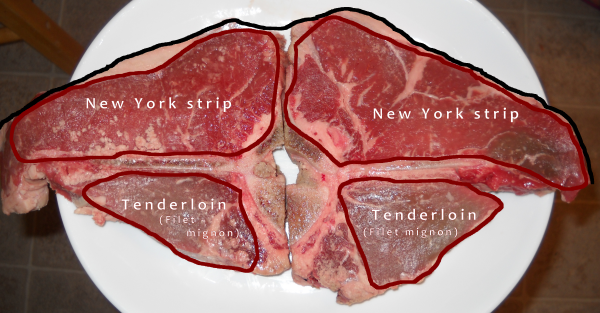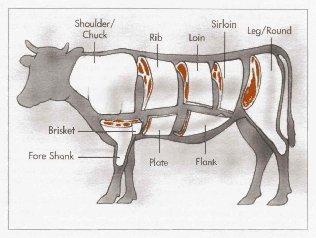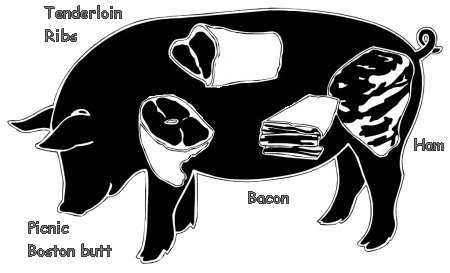Steak Lexicon
Butcher or grocery store names in italics.
Strip steaks: top loin, sirloin, strip, shell, New York,
Kansas City—chewy with beefy flavor; fat around perimeter.
If you wish to pan-sear, these are the best, also excellent grilled
over fire.
Rib steaks: ribeye, Delmonico, Spencer—fine,
smooth texture and rich flavor. Noticeable fat marbling
throughout steak. Excellent grilled over fire; pan-searing not
advised as it will not properly dispose of large concentrations of
fat in marbling (the fat ends up in the pan with the steak).
Tenderloin steaks: filet mignon, Châteaubriand,
tournedos—very tender and extremely mild flavor. These are
the leanest steaks. Filet mignon is frequently bacon-wrapped to
enhance its flavor.
Chuck steaks: chuck, blade, chuck-eye,
flat iron—flavorful, well marbled, less expensive,
nearer the shoulder, more connective tissue. Very good grilled over
fire.
-
Flat iron steaks: Over the shoulder and down the front
from the chuck, the flat iron originates in a muscle group from
which cross-rib roasts and two flat iron steaks are cut. The flat
iron is gaining in popularity, in particular in the mid-West.
While well marbled, the flat iron is surprisingly devoid of
connective tissue.
Flank steaks: tougher, but usually sliced thin used for
carne asada, pan-seared, stir fry and filled rolls.
Round steaks: Lean, flavorless, inedible dog
food—should have been thrown into a grinder with fat to make
hamburger.
Smoke point of fats
| Safflower | 450°F |
| Peanut | 450°F |
| Canola | 435°F |
| Corn | 410°F |
| Olive | 375°F |
| Rendered butter | 350°F |
| Butter | 300°F |
|
Roast Lexicon
Butcher or grocery store names in italics.
Sirloin roasts: tri-tip—chewy with beefy
flavor; fat around perimeter.
Rib roasts: ribeye, prime rib—fine, smooth
texture and rich flavor. Noticeable fat marbling throughout roast.
Excellent slow cooked to rare, medium rare, etc.
Short loin roasts: filet mignon,
tenderloin—lean, very tender and mild flavor.
Chuck roasts: 7-bone, cross-rib,
chuck-eye—flavorful, well marbled, less expensive,
nearer the shoulder, more connective tissue. Very good as pot roast
if properly and carefully cooked.
Round roasts: tip, round tip, bottom round, eye of
round, rump—lean, flavorless, inedible dog food—should
have been thrown into a grinder with fat to make hamburger.
Roasting meat, basic steps
1. Season meat (salt & pepper, overnight marinade or
apply a rub of blended spices).
2. Sear meat in 450° skillet, 2 minutes per side.
3. Place meat on rack, roast to 375° until done
(appropriate internal temperature).
4. Let rest 8 minutes per pound; do not cover (or tent).
Miscellaneous facts
Steak comes from Anglo Saxon steik, meaning
"meat on a spit."
To clean cast iron skillet scrub with Kosher salt until clean,
then discard—no water.
Papain doesn't tenderize just sitting there: you have to apply heat!
Cook marinated skirt steak directly on charcoal briquettes that
have been "dusted" with a hair dryer.
Fajita comes from Spanish faja, meaning "girdle" or "strip."
Cooking hot and fast? Avoid names for cuts containing tri-tip,
ball-tip and butt.
|
|


